Dose-Confirmation Studies
Three studies were conducted to confirm the efficacy of the Exzolt dosage regimen found effective in previous dose-determination studies (0.5 mg fluralaner/kg BW in drinking water twice at a 7-day interval). The 3 studies, conducted under a common protocol at commercial laying farms of different sizes in Germany, France, and Spain, evaluated Exzolt dose efficacy for treating natural infestations of Poultry Red Mites (D. gallinae).38
To read Poultry Red Mite study details, click here.
A study was also conducted in the US to confirm that the Exzolt dosage regimen selected for Poultry Red Mites in chickens was also relevant for treating Northern Fowl Mites. This study evaluated the efficacy of oral fluralaner and was evaluated at 3 dosing regimens in layers infested with Northern Fowl Mites.
To read Northern Fowl Mite study details, click here.
Poultry Red Mite Studies
Unlike the previous dose-determination studies that directly evaluated efficacy by killing mites feeding on treated animals, these dose-confirmation studies assessed the effect of treatment on the reduction of the mite population in the house.

Study Design

- Three controlled, single-site dose-confirmation studies. Each study involved a qualifying commercial laying hen farm (in Germany, France, or Spain) with 2 comparable houses naturally infested with poultry red mites (no recent acaricide treatment).
- The 2 houses at each of the 3 enrolled farms were as similar as possible with regard to size, breed, and age of chickens; feed/water distribution systems; and housing system (Table 5-1).
- Mite infestation levels of each house were assessed using mite traps, with farm eligibility confirmed if mite counts averaged > 100 in each house. Field isolates of study mites were confirmed to be susceptible to fluralaner using a contact in vitro test (LC90 < 15.63 ppm).
- On day 0 at each farm, birds in 1 house were treated with Exzolt (0.5 mg/kg BW/day twice 7 days apart) and the remaining house was left untreated (controls). Houses with the highest mite infestations were selected for Exzolt treatment, for animal welfare reasons. Treatment was administered either using a medication tank or a dosing pump.
- Additional mite traps were placed at the same locations on day -1 (baseline infestation level) and at multiple time-points thereafter. Traps were removed after 24 hours for mite differentiation and counting.
- Data were also collected regarding adverse events and the number of dead chickens, laid eggs, and downgraded eggs (study B) per house.
- Personnel involved in the assessment of efficacy and safety criteria were blinded to treatment group assignments.
Efficacy Criteria
Efficacy assessment was based on the percentage reduction of mites (mobile stages, i.e., larvae, nymphs, adults) in the treated house at each post treatment time-point compared to the control house.
Production parameters were descriptively analyzed.
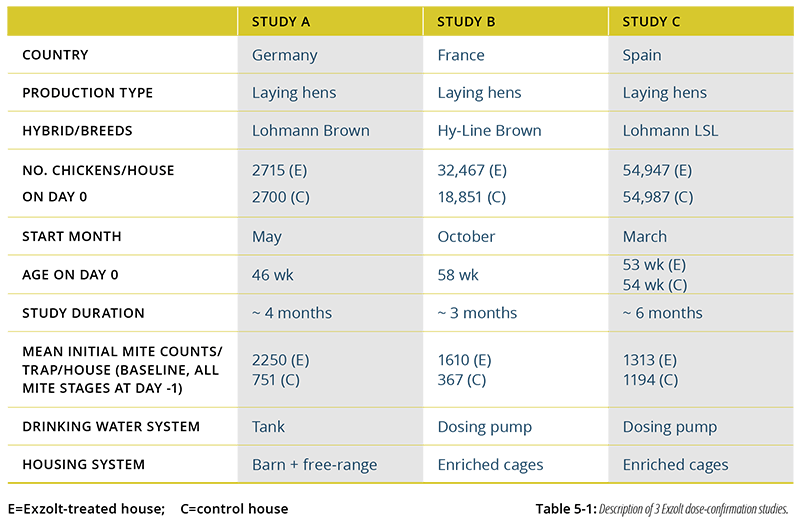
RESULTS
Study A was concluded after 4 months because mite counts decreased spontaneously in the control group. Study B was concluded at the end of the scheduled production cycle of the hens, after about 3 months. Study C extended about 6 months, until regrowth of the mite population in the treated house reached 50% of the baseline count. However, the birds in the control house received treatment with another product at week 11 (day 77) to ensure appropriate animal welfare. Analyses of water samples from all 3 studies confirmed that actual fluralaner concentrations were generally close to target levels.
The efficacy of Exzolt against all mite stages compared to controls is summarized in Figure 5-2. For all studies, efficacy resulting from the complete 2-dose regimen exceeded 99% from day 6 onwards, achieving 100% at several time-points. Efficacy remained high through the end of the production cycle in study B (3 months) and for 17 and 19 weeks in studies A and C, respectively.
As expected, Exzolt efficacy against larval non-blood-feeding stages of mites (Figure 5-3) increased more slowly than efficacy against nymphs and/or adults. However, as larval stages progressed to later blood-feeding forms, Exzolt efficacy was more consistently detected, with more than 95% efficacy confirmed by day 6 (before the second administration). Thereafter, mite counts for larvae, nymphs, and adults were similar.
Favorable impacts of effective mite control were also observed for several production parameters (Figure 5-4). For each parameter, the difference between the Exzolt group and controls was calculated pre-treatment (week -1) and post treatment (from first treatment through study conclusion). Mortality remained very low in both houses of each study. Overall, birds treated with Exzolt experienced an increase in the laying rate (0.9-1.9%) and a decrease in the percentage of downgraded eggs in study B (3.4% more normal eggs). These productivity benefits reflect the successful and prolonged relief of ectoparasite burdens by Exzolt, which thus allowed for better productivity in these field studies.
No adverse events related to the use of Exzolt were reported during the studies.
CONCLUSION
Dose-confirmation studies demonstrated that Exzolt consistently provided high efficacy against poultry red mites when administered at 0.5 mg fluralaner/kg BW given twice 7 days apart via drinking water. Treated birds also demonstrated excellent tolerance of Exzolt, with no treatment-related adverse effects observed. Under commercial production conditions in these studies, the 2-dose Exzolt regimen successfully controlled mite infestations for extended periods far exceeding the 2 weeks of effective blood concentrations. This extended period of efficacy was due to the ability of Exzolt to interrupt mite life cycles and, thus, massively decrease mite populations of the houses.
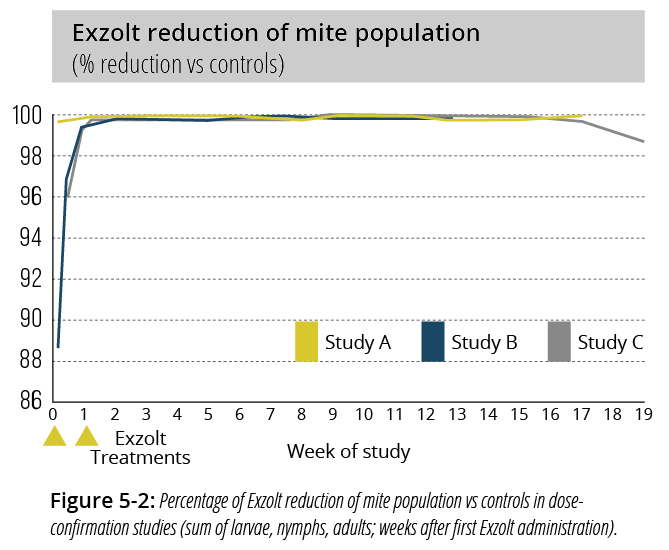
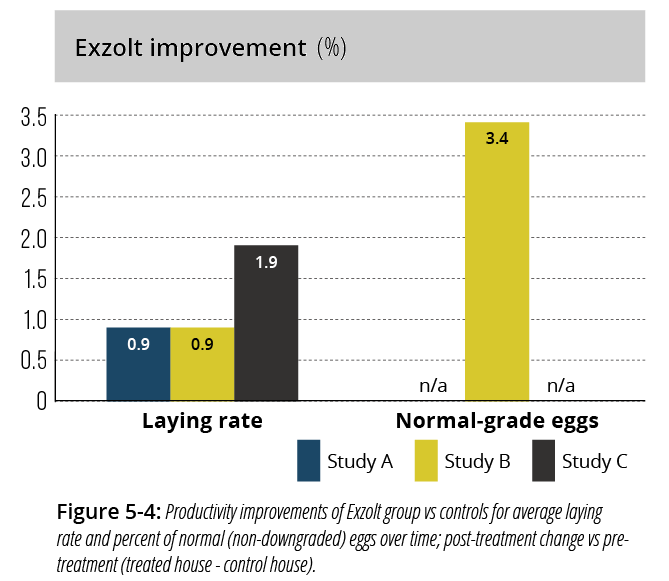
Northern Fowl Mite Study
All 3 treatment groups experienced efficacy higher than 90% through day 19 or 22, and mite counts were significantly reduced compared to control groups on day 22. The study was then able to conclude that Exzolt provided an efficacy profile similar to that provided for Poultry Red Mites, even when a test-scenario involved continually re-infesting treated birds.
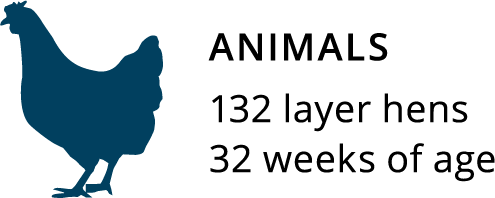
Study Design
- A controlled, randomized dose-confirmation study. Hens originating from an infested flock were distributed in 12 pens (11 birds/pen); 3 pens were then allocated according to vent mite-count densities to either of 4 treatment groups.
- Exzolt treatments were administered via drinking water (first dose=day 0) as follows:
- Group A: untreated control group
- Group B: 0.25 mg fluralaner/kg BW/day twice 7 days apart
- Group C: 0.5 mg fluralaner/kg BW/day twice 7 days apart
- Group D: 1.0 mg fluralaner/kg BW/day twice 7 days apart
- 6 hens in each pen were treated by gavage and 5 were left untreated to maintain an infestation challenge (permanent mite re-infestation). Pre-treatment mite counts ranged from 10 to 288/hen.
- Mite counts were performed using 2 feathers around the vent area taken from a randomly selected hen in each pen. Counts were conducted on days -1, 1, 2, 6, 8, 12, 15, 19, 22, and 26.
Efficacy Criteria
Efficacy assessment was based on the percent reduction of mites on treated hens compared to untreated controls.
Results
All 3 Exzolt treatment groups experienced high efficacy (>90%) through day 19 or 22, and mite counts were significantly (P ≤ 0.013) reduced compared to controls through day 22. The efficacy of the recommended Exzolt dose appears in Figure 5-8.
Conclusion
The recommended Exzolt dosage regimen of 0.5mg fluralaner/kg BW twice at a 7-day interval achieved 98% efficacy against Northern Fowl Mites for at least 15 days, covering at least 2 mite life cycles. Exzolt provided an efficacy profile against O. sylviarum similar to that provided for D. gallinae, even under a ‘worst case’ test scenario involving permanent re-infestation of treated birds due to the continuous presence of untreated mite-source hens in the same pen. (Under typical field conditions, all birds of a same flock would be treated, thus potentially allowing for total eradication of the mite population.)
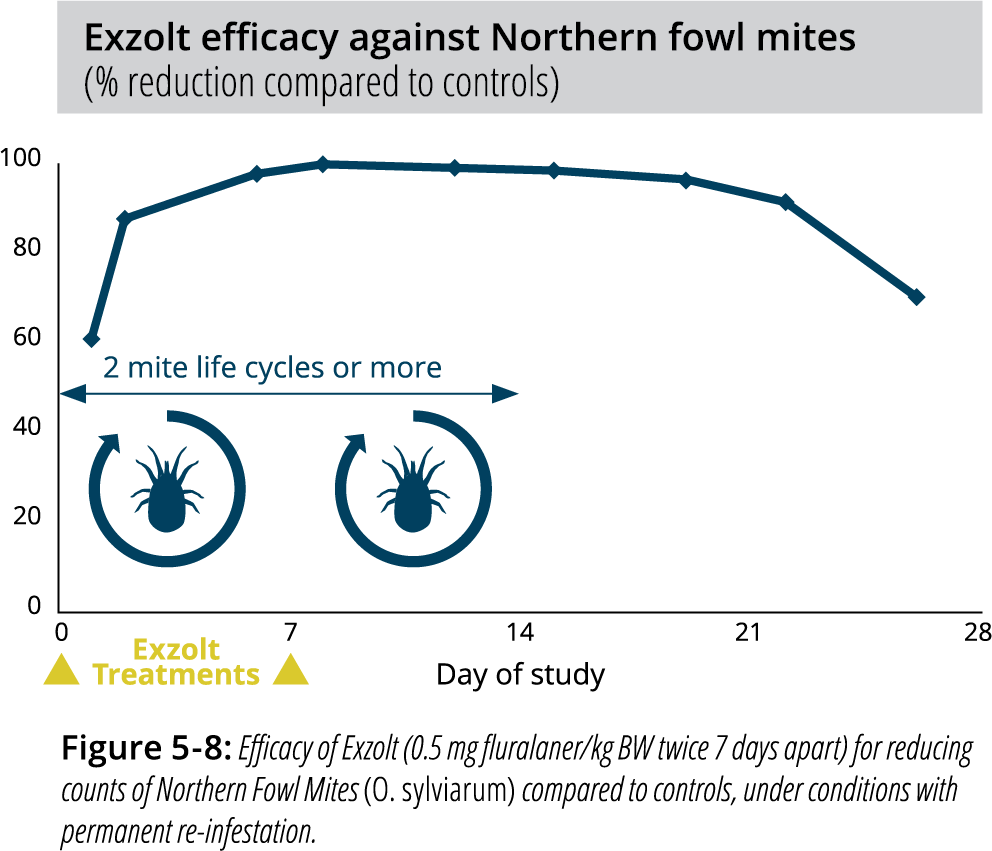
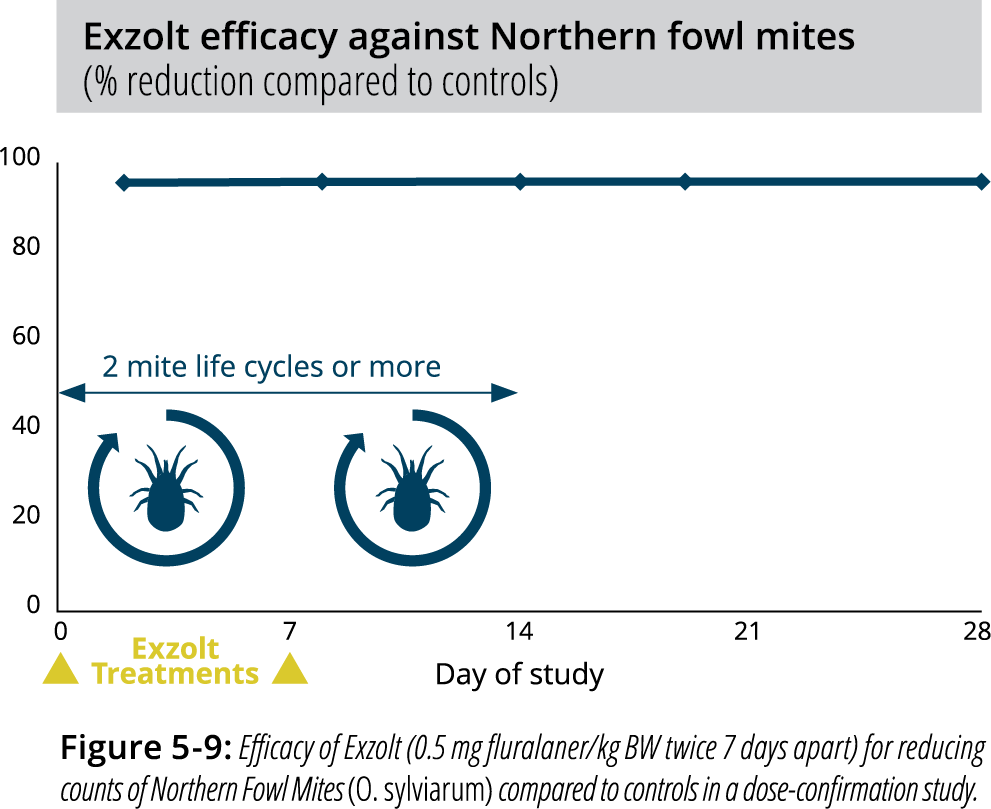
1 Data on file. MSD Animal Health.
Mixing & Administration Guide
The Exzolt Mixing and Administration Guide provides a concise, step-by-step outline to help practitioners and producers get started with proper administration of medication for treatment. The guide provides instruction to ensure Exzolt is dosed, mixed and used correctly.


